Research on Propagation Characteristics Based on Channel Measurements and Simulations in a Typical Open Indoor Environment
Abstract
:1. Introduction
2. Theory
2.1. Ray Tracing Method
| Algorithm 1 Determine the Electric Field caused by direct ray between Transmitter and Receiver |
| 1: procedure Electric field E |
| 2: m ▷The connection ray between the transmitter and receiver |
| 3: tt, cc ▷intersection, walls |
| 4: for cc do |
| 5: tt ← Determine if the ray m has an intersection tt with an wall cc |
| 6: if The intersection is on the wall then |
| 7: T ← Calculation transmission coefficient between the transmitter and receiver |
| 8: else |
| 9: T = 1 |
| 10: end if |
| 11: end for 12: E ← Calculate the electric field caused by direct ray/transmission 13: return E |
| 14: end procedure |
| Algorithm 2 Determine the Electric Field caused by single reflection/transmission path between Transmitter and Receiver |
| 1: procedure Electric field E1 |
| 2: m ▷The connection ray between single image point and receiver 3: m1 ▷The connection ray between transmitter and reflection point 4: m2 ▷The connection ray between reflection point and receiver 5: tt, cc ▷Intersection of single image point and receiver with walls, walls 6: tt1 ▷Intersection of transmitter and reflection point with walls 7: tt2 ▷Intersection of receiver and reflection point with walls |
| 8: for cc do 9: R ▷reflection coefficient between transmitter and receiver |
| 10: tt ← Determine if the ray m has an intersection tt with walls cc |
| 11: if The intersection is on the wall then |
| 12: R ← Calculation of reflection coefficient R according to Fresnel’s Formula |
| 13: for cc do |
| 14: tt1 ← Determine if the ray m1 has an intersection tt1 with walls cc 15: if The intersection is on the wall then 16: T1 ← Calculate transmission coefficient between transmitter and reflection point 17: else 18: T1 = 1 19: end if 20: end for 21: for cc do 22: tt2 ← Determine if the ray m2 has an intersection tt2 with walls cc 23: if The intersection is on the wall then 24: T2 ← Calculate transmission coefficient between reflection point and receiver 25: else 26: T2 = 1 27: end if 28: end for 29: E11 ← Calculate the electric field caused by each path |
| 30: end if |
| 31: end for 32: E1 ← Calculate the total electric field caused by single reflection/transmission 33: return E1 |
| 34: end procedure |
2.2. SAGE Algorithm
2.2.1. Signal Model in Translational Scanning System
2.2.2. Signal Model in Rotary Scanning System
2.3. Deep Learning Models and Performance Assessment Metrics
3. Channel Measurement in a Typical Open Indoor Environment
3.1. Channel Measurements in Office Scenarios
3.2. Channel Measurements in Conference Room Scenarios
4. Analysis: Comparison of Theory and Experiments
4.1. Analysis in Office Scenarios
4.1.1. Analysis of Path Loss for 28 GHz and 38 GHz
4.1.2. Analysis of Received Power and Ray Path Diagram for 28 GHz and 38 GHz
4.1.3. Analysis of SAGE Algorithm for 28 GHz and 38 GHz
4.2. Analysis in Conference Room Scenarios
4.2.1. Analysis of Path Loss for 39 GHz and 65.5 GHz
4.2.2. Analysis of Received Power and Ray Path Diagram for 39 GHz and 65.5 GHz
4.2.3. Analysis of the SAGE Algorithm for 39 GHz and 65.5 GHz
4.3. Predicting the Path Loss Using Deep Learning Models
5. Conclusions
Author Contributions
Funding
Data Availability Statement
Acknowledgments
Conflicts of Interest
References
- Mitra, R.N.; Agrawal, D.P. 5G mobile technology: A survey. ICT Express 2015, 1, 132–137. [Google Scholar] [CrossRef]
- Hur, S.; Baek, S.; Kim, B.; Chang, Y.; Molisch, A.F.; Rappaport, T.S.; Haneda, K.; Park, J. Proposal on millimeter-wave channel modeling for 5G cellular system. IEEE J. Sel. Top. Signal Process. 2016, 10, 454–469. [Google Scholar] [CrossRef]
- del Peral-Rosado, J.; Granados, G.; Raulefs, R.; Leitinger, E.; Grebien, S.; Wilding, T.; Dardari, D.; Lohan, E.; Wymeersch, H.; Floch, J. Whitepaper on new localization methods for 5G wireless systems and the Internet-of-Things. In White Paper of the COST Action CA15104 (IRACON); COST Action CA15104, IRACON; 2018; pp. 1–27. Available online: https://re.public.polimi.it/bitstream/11311/1069386/2/2018_white_paper_IRACON-WP2.pdf (accessed on 30 May 2023).
- Papazian, P.B.; Gentile, C.; Remley, K.A.; Senic, J.; Golmie, N. A radio channel sounder for mobile millimeter-wave communications: System implementation and measurement assessment. IEEE Trans. Microw. Theory Tech. 2016, 64, 2924–2932. [Google Scholar] [CrossRef]
- Rappaport, T.S.; Xing, Y.; MacCartney, G.R.; Molisch, A.F.; Mellios, E.; Zhang, J. Overview of millimeter wave communications for fifth-generation (5G) wireless networks—With a focus on propagation models. IEEE Trans. Antennas Propag. 2017, 65, 6213–6230. [Google Scholar] [CrossRef]
- Jondhale, S.R.; Mohan, V.; Sharma, B.B.; Lloret, J.; Athawale, S.V. Support vector regression for mobile target localization in indoor environments. Sensors 2022, 22, 358. [Google Scholar] [CrossRef]
- Yun, Z.; Iskander, M.F. Ray tracing for radio propagation modeling: Principles and applications. IEEE Access 2015, 3, 1089–1100. [Google Scholar] [CrossRef]
- Geok, T.K.; Hossain, F.; Kamaruddin, M.; Rahman, N.; Thiagarajah, S.; Chiat, A.T.W.; Liew, C. A comprehensive review of efficient ray-tracing techniques for wireless communication. Int. J. Commun. Antenna Propag. 2018, 8, 123–136. [Google Scholar] [CrossRef]
- Cao, Y.-W.; Liu, Z.-Y.; Guo, L.-X. A Fast Ray-tracing-based Algorithm for Very Low Frequency Radio Propagation. In Proceedings of the 2019 Cross Strait Quad-Regional Radio Science and Wireless Technology Conference (CSQRWC), Taiyuan, China, 18–21 July 2019; IEEE: Piscataway, NJ, USA, 2019; pp. 1–2. [Google Scholar]
- Rubio, L.; Peñarrocha, V.M.R.; Cabedo-Fabres, M.; Bernardo-Clemente, B.; Reig, J.; Fernández, H.; Pérez, J.R.; Torres, R.P.; Valle, L.; Fernández, Ó. Millimeter-Wave Channel Measurements and Path Loss Characterization in a Typical Indoor Office Environment. Electronics 2023, 12, 844. [Google Scholar] [CrossRef]
- Lawton, M.; Davies, R.; McGeehan, J.P. A ray launching method for the prediction of indoor radio channel characteristics. In Proceedings of the IEEE International Symposium on Personal, Indoor and Mobile Radio Communications, Bristol, UK, 23–25 September 1991; IEEE: Piscataway, NJ, USA, 1991; pp. 104–108. [Google Scholar]
- Fortune, S. Efficient algorithms for prediction of indoor radio propagation. In Proceedings of the VTC’98, 48th IEEE Vehicular Technology Conference, Pathway to Global Wireless Revolution (Cat. No. 98CH36151), Ottawa, ON, Canada, 21 May 1998; IEEE: Piscataway, NJ, USA, 1998; pp. 572–576. [Google Scholar]
- Hoppe, R.; Wertz, P.; Landstorfer, F.M.; Wölfle, G. Advanced ray-optical wave propagation modelling for urban and indoor scenarios including wideband properties. Eur. Trans. Telecommun. 2003, 14, 61–69. [Google Scholar] [CrossRef]
- Degli-Esposti, V.; Falciasecca, G.; Fuschini, F.; Vitucci, E. A meaningful indoor path-loss formula. IEEE Antennas Wirel. Propag. Lett. 2013, 12, 872–875. [Google Scholar] [CrossRef]
- Wallace, J.W.; Ahmad, W.; Yang, Y.; Mehmood, R.; Jensen, M.A. A comparison of indoor MIMO measurements and ray-tracing at 24 and 2.55 GHz. IEEE Trans. Antennas Propag. 2017, 65, 6656–6668. [Google Scholar] [CrossRef]
- Geok, T.K.; Hossain, F.; Chiat, A.T.W. A novel 3D ray launching technique for radio propagation prediction in indoor environments. PLoS ONE 2018, 13, e0201905. [Google Scholar] [CrossRef] [PubMed]
- He, D.; Ai, B.; Guan, K.; Wang, L.; Zhong, Z.; Kürner, T. The design and applications of high-performance ray-tracing simulation platform for 5G and beyond wireless communications: A tutorial. IEEE Commun. Surv. Tutor. 2018, 21, 10–27. [Google Scholar] [CrossRef]
- Chen, Y.-S.; Lai, F.-P.; You, J.-W. Analysis of antenna radiation characteristics using a hybrid ray tracing algorithm for indoor WiFi energy-harvesting rectennas. IEEE Access 2019, 7, 38833–38846. [Google Scholar] [CrossRef]
- Hossain, F.; Geok, T.K.; Rahman, T.A.; Hindia, M.N.; Dimyati, K.; Ahmed, S.; Tso, C.P.; Abd Rahman, N.Z. An efficient 3-D ray tracing method: Prediction of indoor radio propagation at 28 GHz in 5G network. Electronics 2019, 8, 286. [Google Scholar] [CrossRef]
- Obeidat, H.; Alabdullah, A.; Elkhazmi, E.; Suhaib, W.; Obeidat, O.; Alkhambashi, M.; Mosleh, M.; Ali, N.; Dama, Y.; Abidin, Z. Indoor environment propagation review. Comput. Sci. Rev. 2020, 37, 100272. [Google Scholar] [CrossRef]
- Ullah, U.; Kamboh, U.R.; Hossain, F.; Danish, M. Outdoor-to-indoor and indoor-to-indoor propagation path loss modeling using smart 3D ray tracing algorithm at 28 GHz mmWave. Arab. J. Sci. Eng. 2020, 45, 10223–10232. [Google Scholar] [CrossRef]
- Lee, J.-H.; Choi, J.-S.; Lee, J.-Y.; Kim, S.-C. Permittivity effect of building materials on 28 GHz mmWave channel using 3D ray tracing simulation. In Proceedings of the GLOBECOM 2017–2017 IEEE Global Communications Conference, Singapore, 4–8 December 2017; IEEE: Piscataway, NJ, USA, 2017; pp. 1–6. [Google Scholar]
- Fleury, B.H.; Tschudin, M.; Heddergott, R.; Dahlhaus, D.; Pedersen, K.I. Channel parameter estimation in mobile radio environments using the SAGE algorithm. IEEE J. Sel. Areas Commun. 1999, 17, 434–450. [Google Scholar] [CrossRef]
- Fleury, B.H.; Jourdan, P.; Stucki, A. High-resolution channel parameter estimation for MIMO applications using the SAGE algorithm. In Proceedings of the 2002 International Zurich Seminar on Broadband Communications Access-Transmission-Networking (Cat. No. 02TH8599), Zurich, Switzerland, 19–21 February 2002; IEEE: Piscataway, NJ, USA, 2002; p. 30. [Google Scholar]
- Fleury, B.H.; Yin, X.; Jourdan, P.; Stucki, A. High-resolution channel parameter estimation for communication systems equipped with antenna arrays. IFAC Proc. Vol. 2003, 36, 97–102. [Google Scholar] [CrossRef]
- He, W.; Wu, Y.; Deng, L.; Li, G.; Wang, H.; Tian, Y.; Ding, W.; Wang, W.; Xie, Y. Comparing SNNs and RNNs on neuromorphic vision datasets: Similarities and differences. Neural Netw. 2020, 132, 108–120. [Google Scholar] [CrossRef] [PubMed]
- Fang, W.; Chen, Y.; Xue, Q. Survey on research of RNN-based spatio-temporal sequence prediction algorithms. J. Big Data 2021, 3, 97. [Google Scholar] [CrossRef]
- Zhao, W.; Zhao, J.; Li, J.; Zhao, D.; Huang, L.; Zhu, J.; Lu, J.; Wang, X. An evaporation duct height prediction model based on a Long Short-Term Memory Neural Network. IEEE Trans. Antennas Propag. 2021, 69, 7795–7804. [Google Scholar] [CrossRef]
- Sundermeyer, M.; Schlüter, R.; Ney, H. LSTM neural networks for language modeling. In Proceedings of the Thirteenth Annual Conference of the International Speech Communication Association, Portland, OR, USA, 9–13 September 2012. [Google Scholar]
- Ji, H.; Yin, B.; Zhang, J.; Zhang, Y.; Li, Q.; Hou, C. Multiscale Decomposition Prediction of Propagation Loss for EM Waves in Marine Evaporation Duct Using Deep Learning. J. Mar. Sci. Eng. 2022, 11, 51. [Google Scholar] [CrossRef]
- Fu, R.; Zhang, Z.; Li, L. Using LSTM and GRU neural network methods for traffic flow prediction. In Proceedings of the 2016 31st Youth Academic Annual Conference of Chinese Association of Automation (YAC), Wuhan, China, 11–13 November 2016; IEEE: Piscataway, NJ, USA, 2016; pp. 324–328. [Google Scholar]
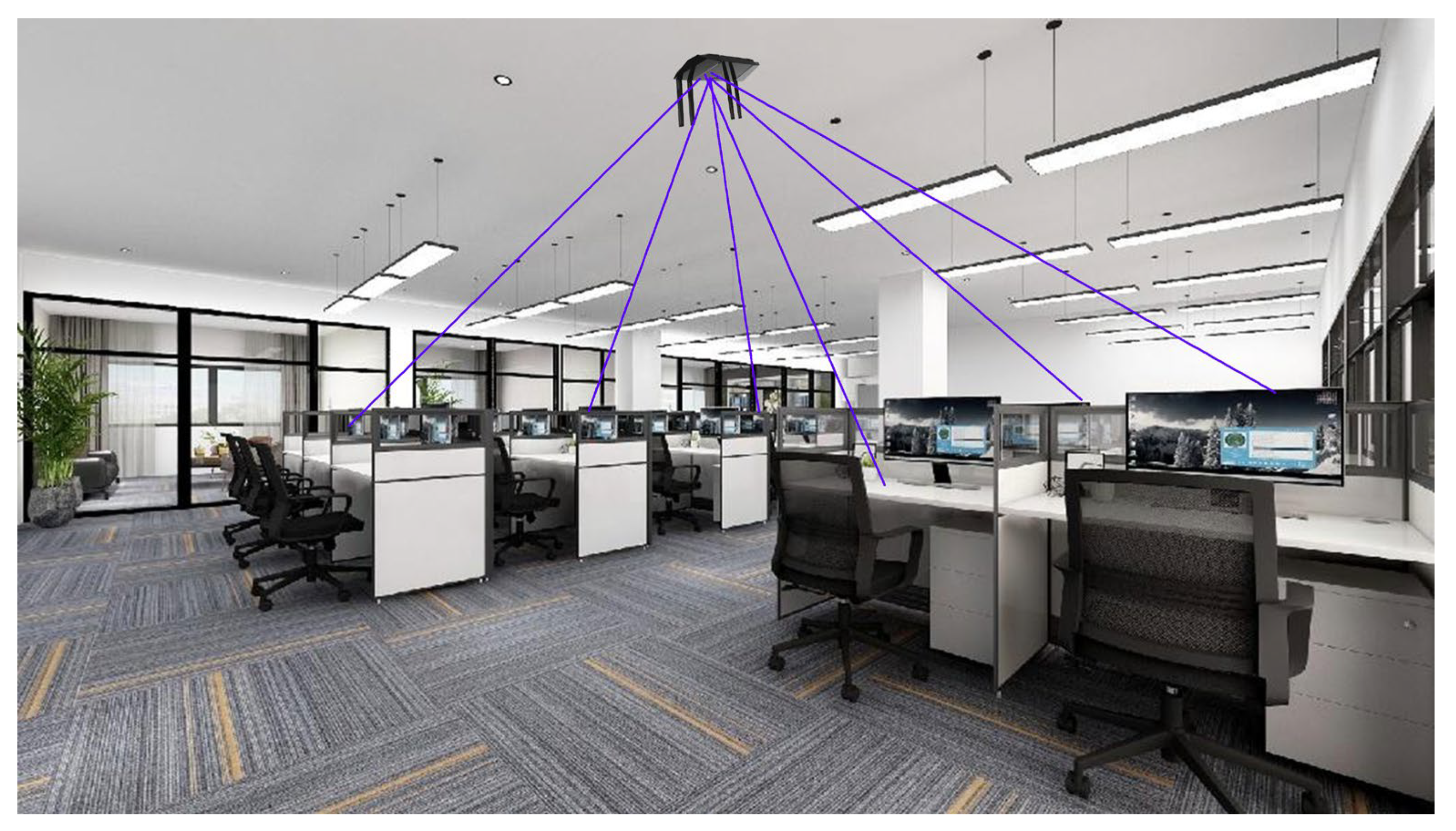

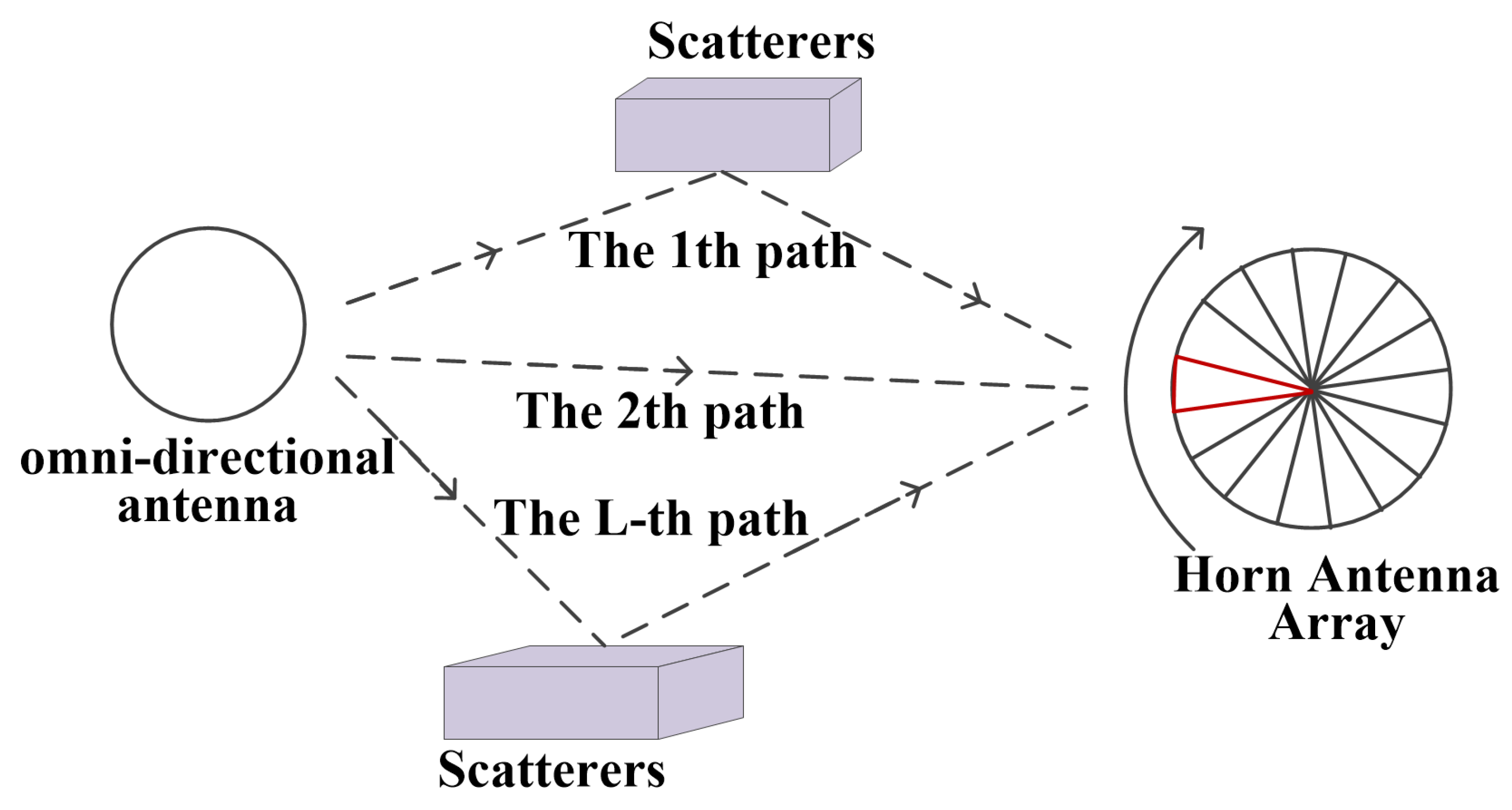
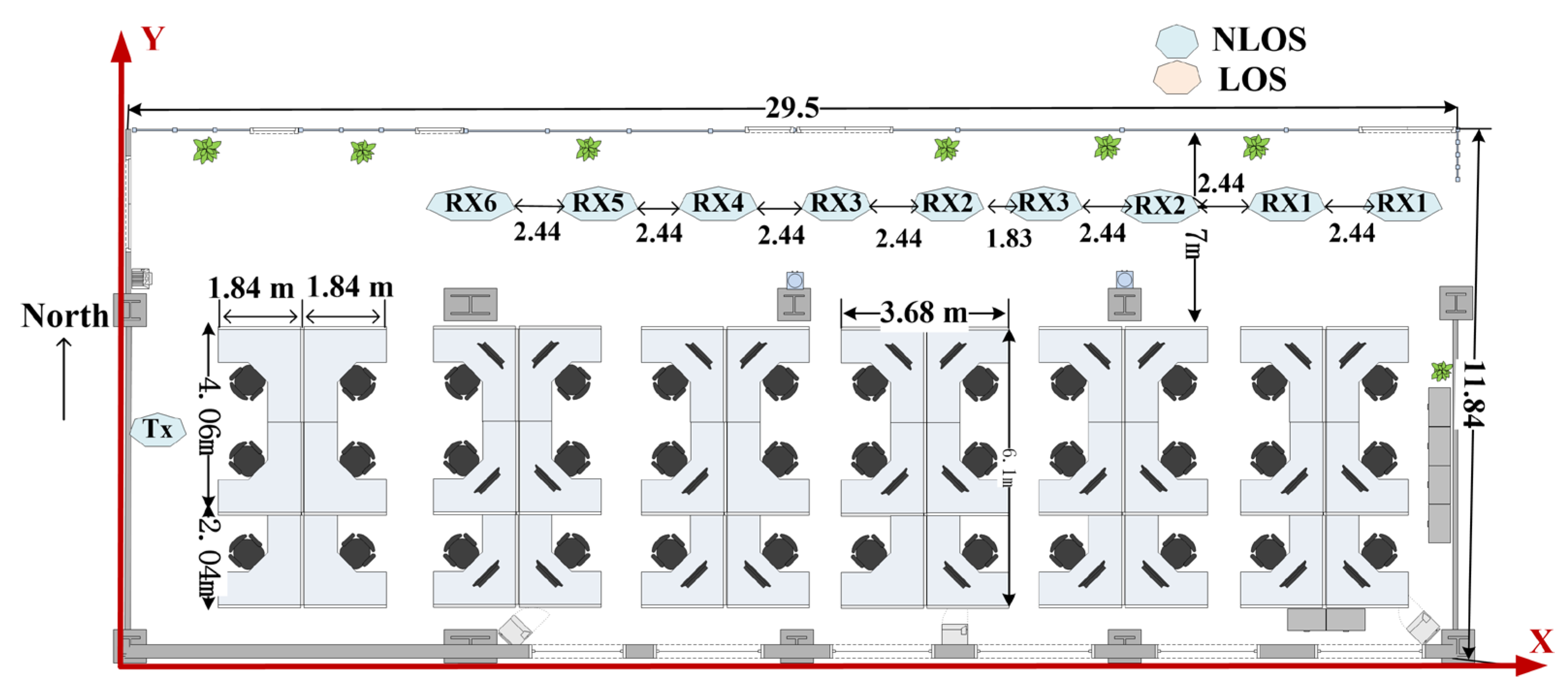
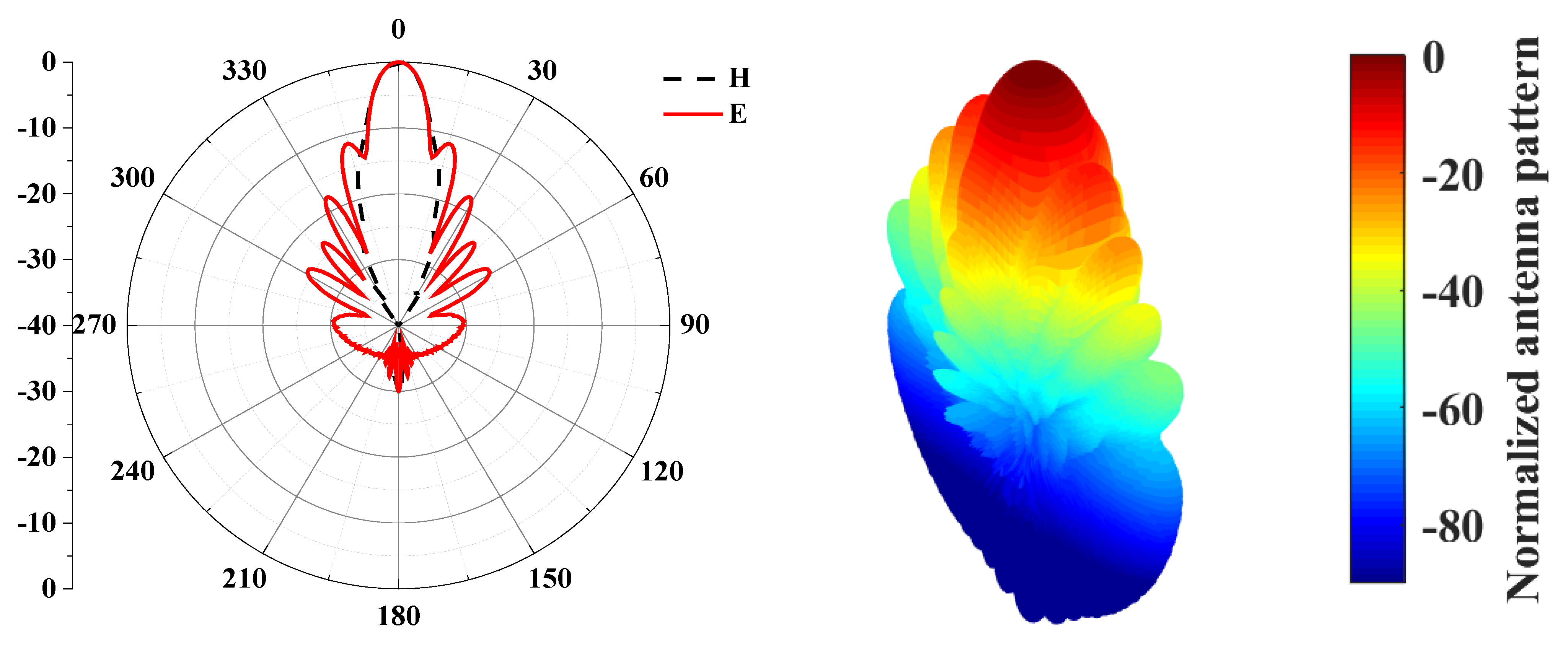
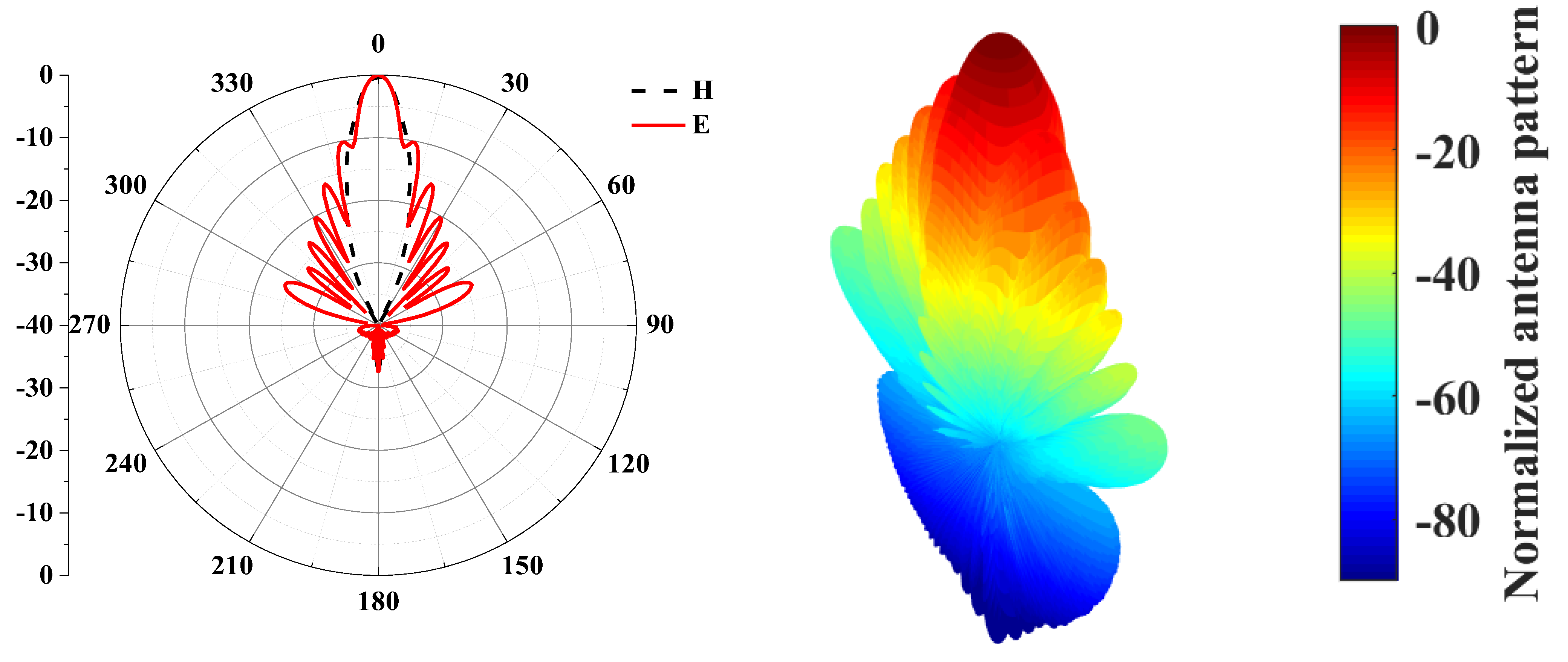

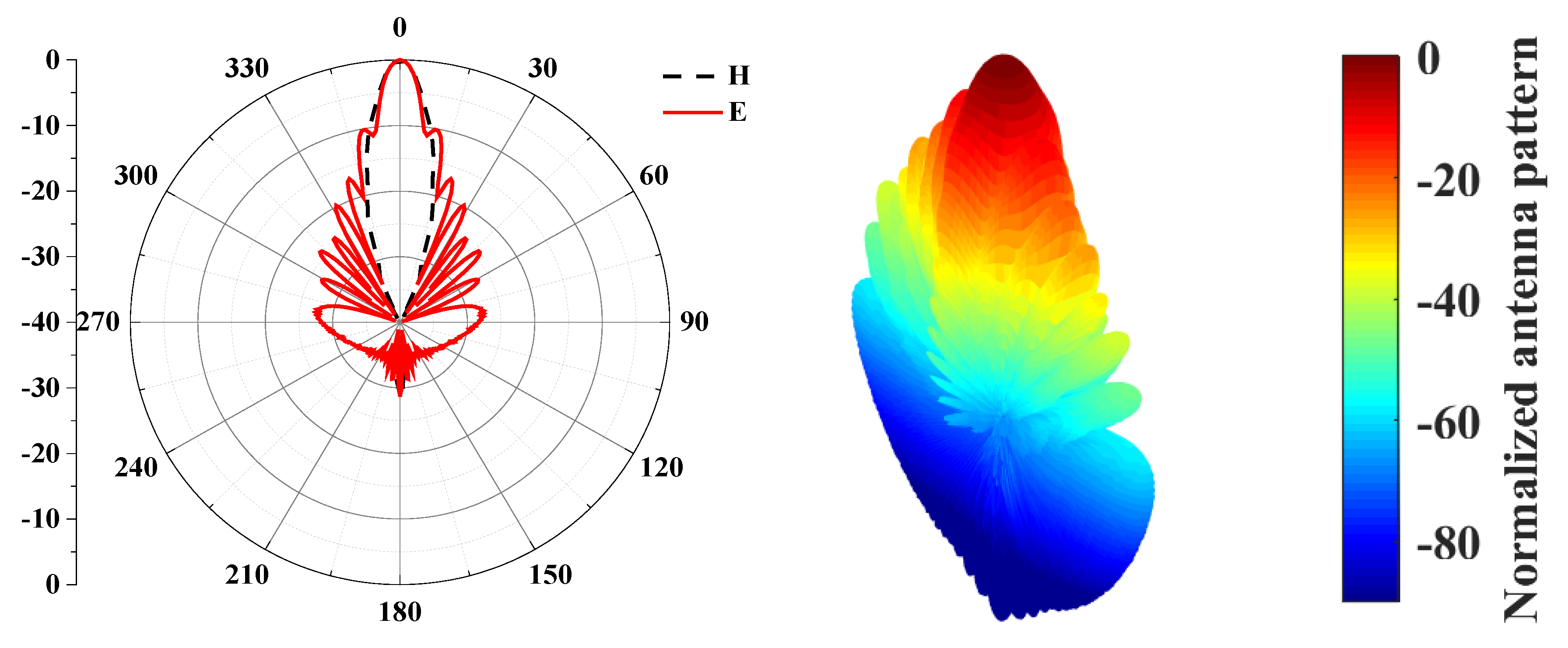
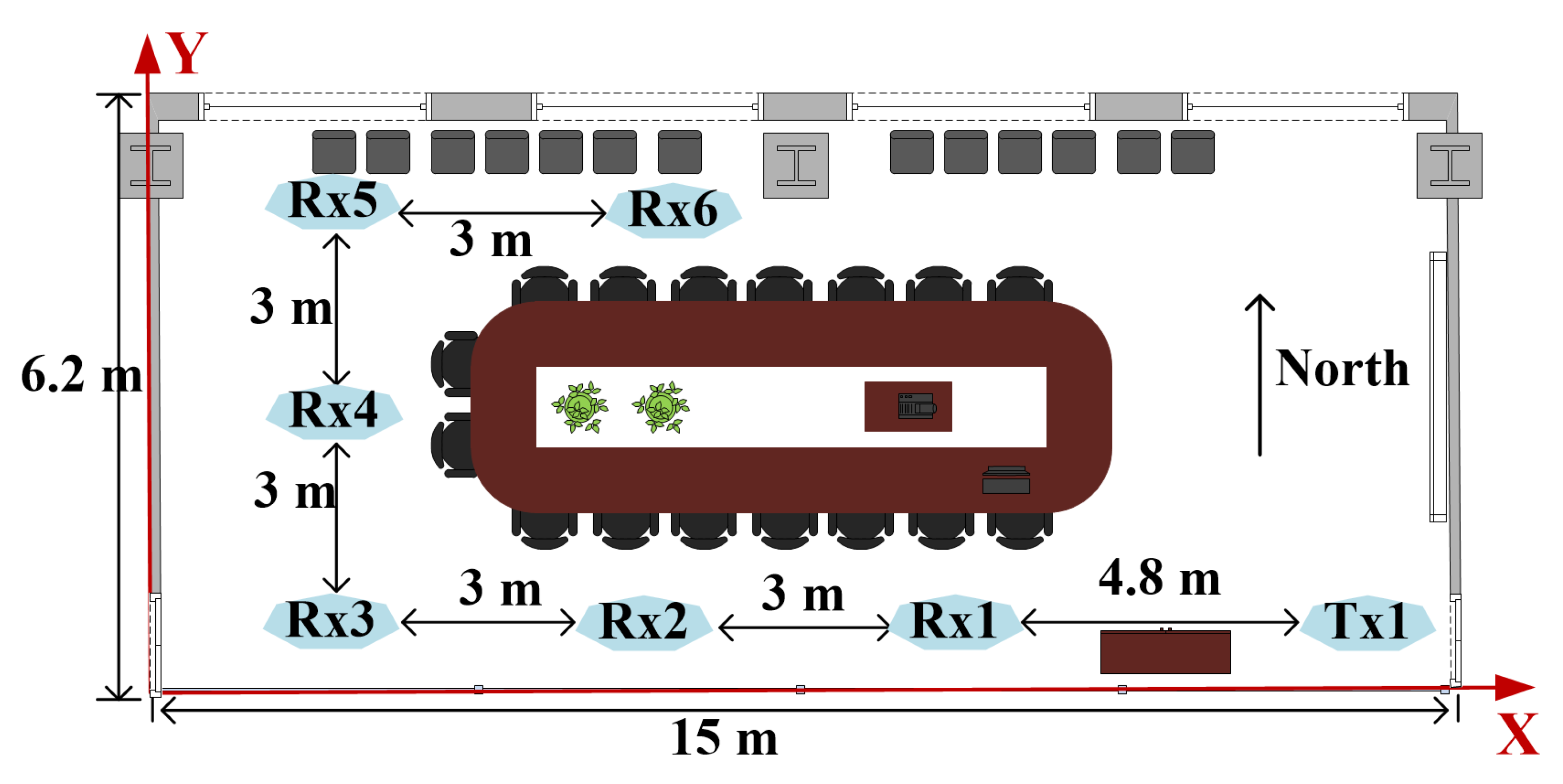
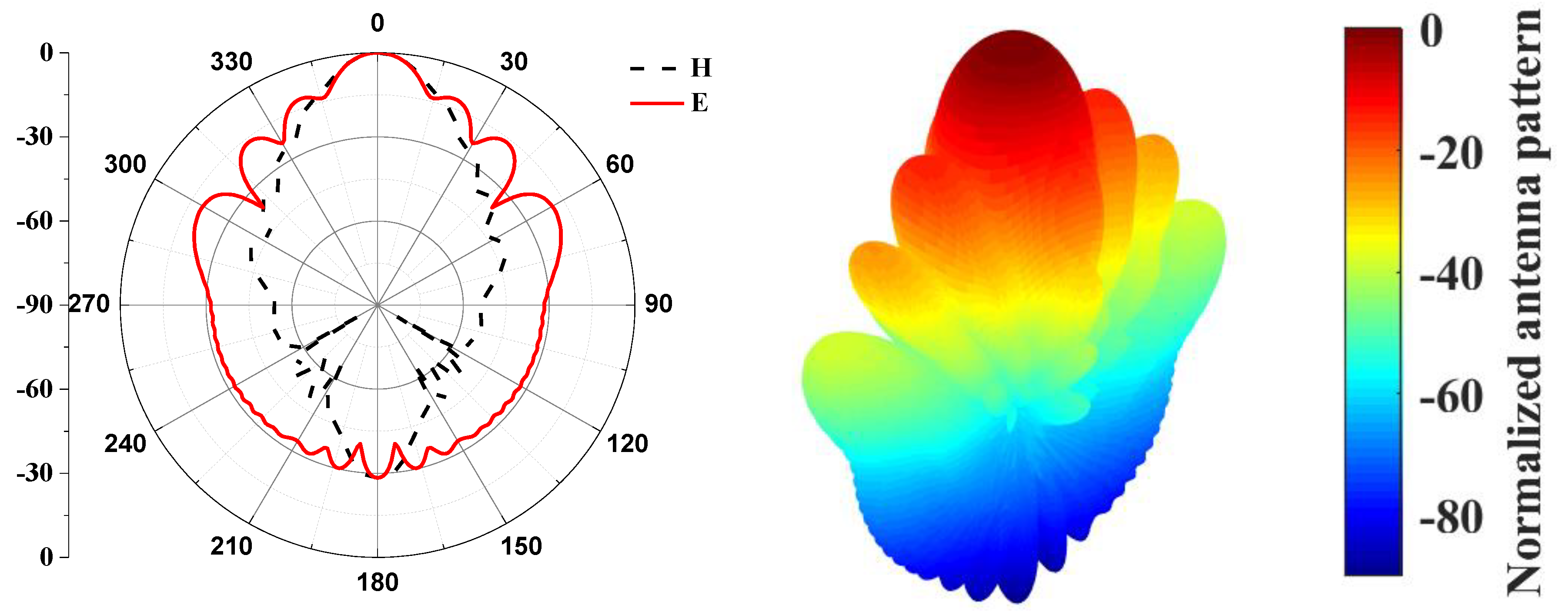
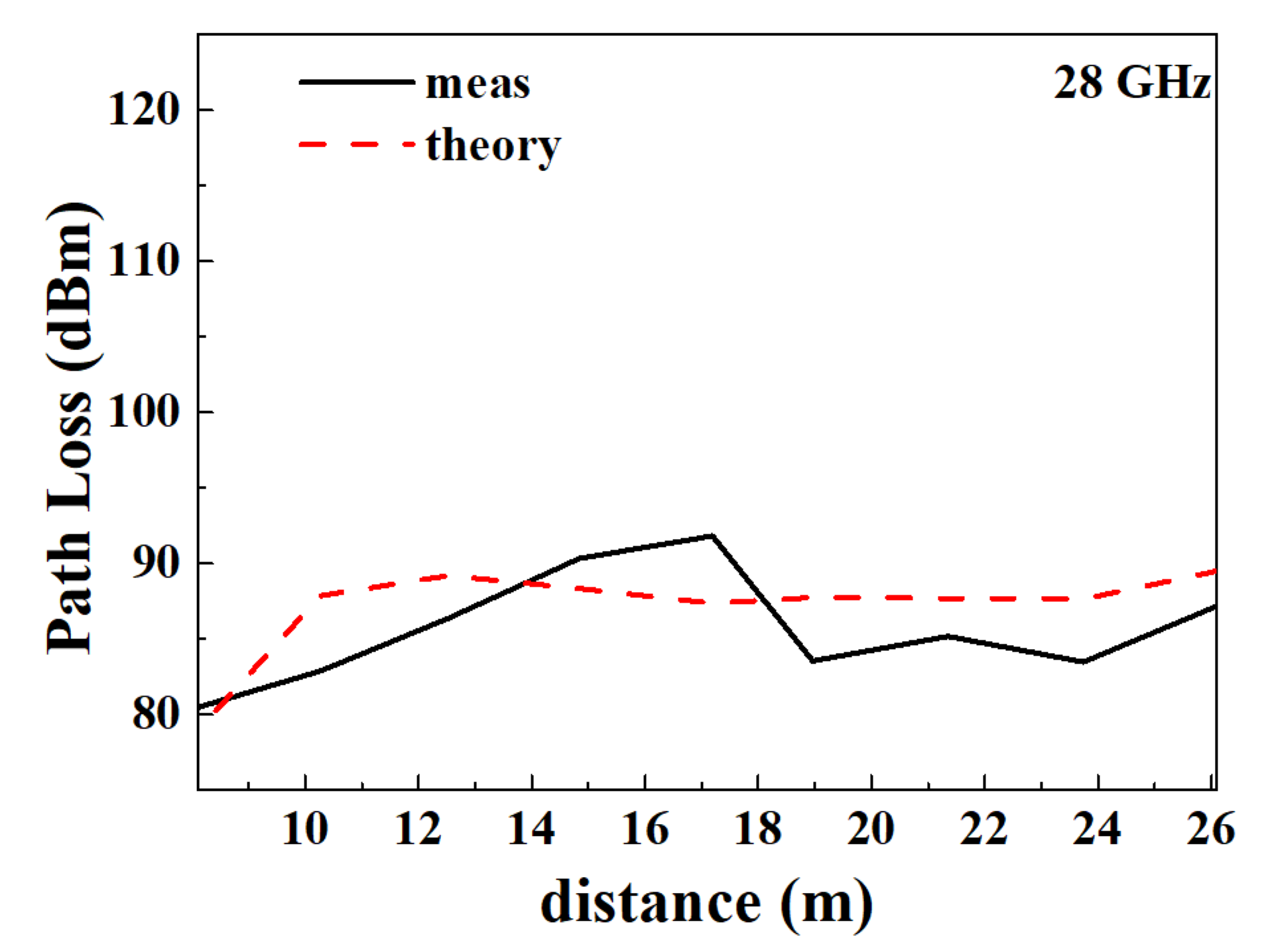
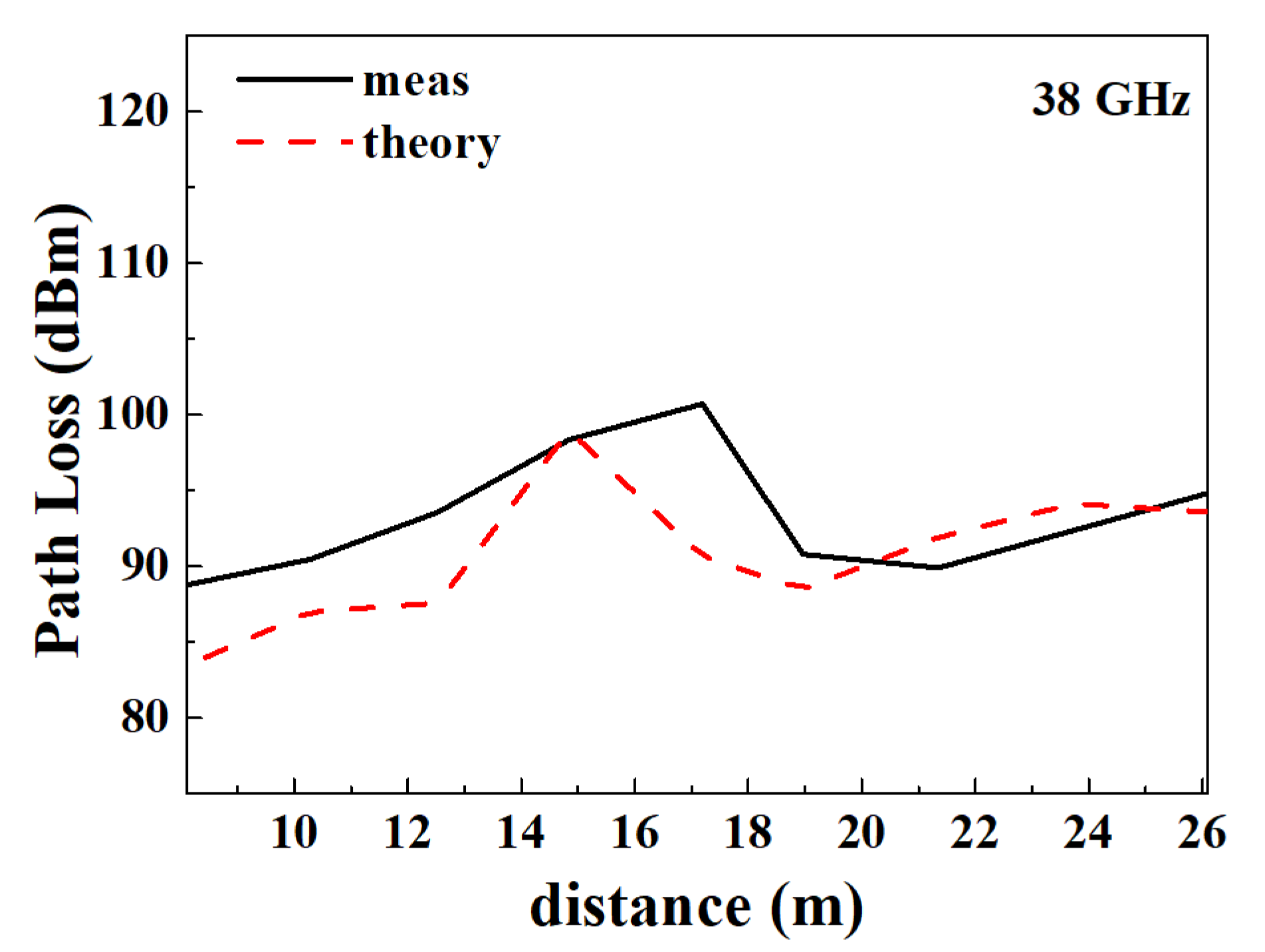
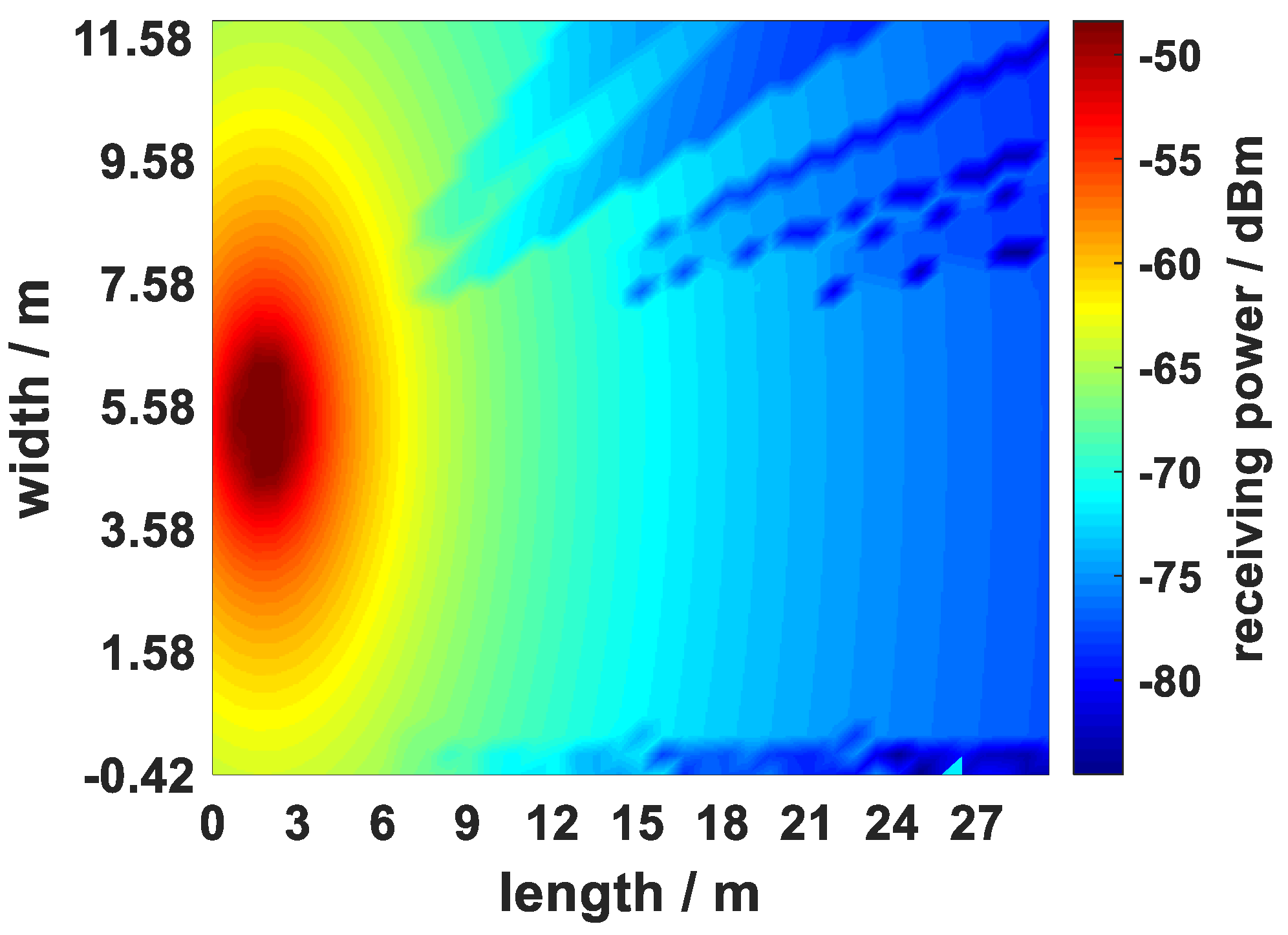
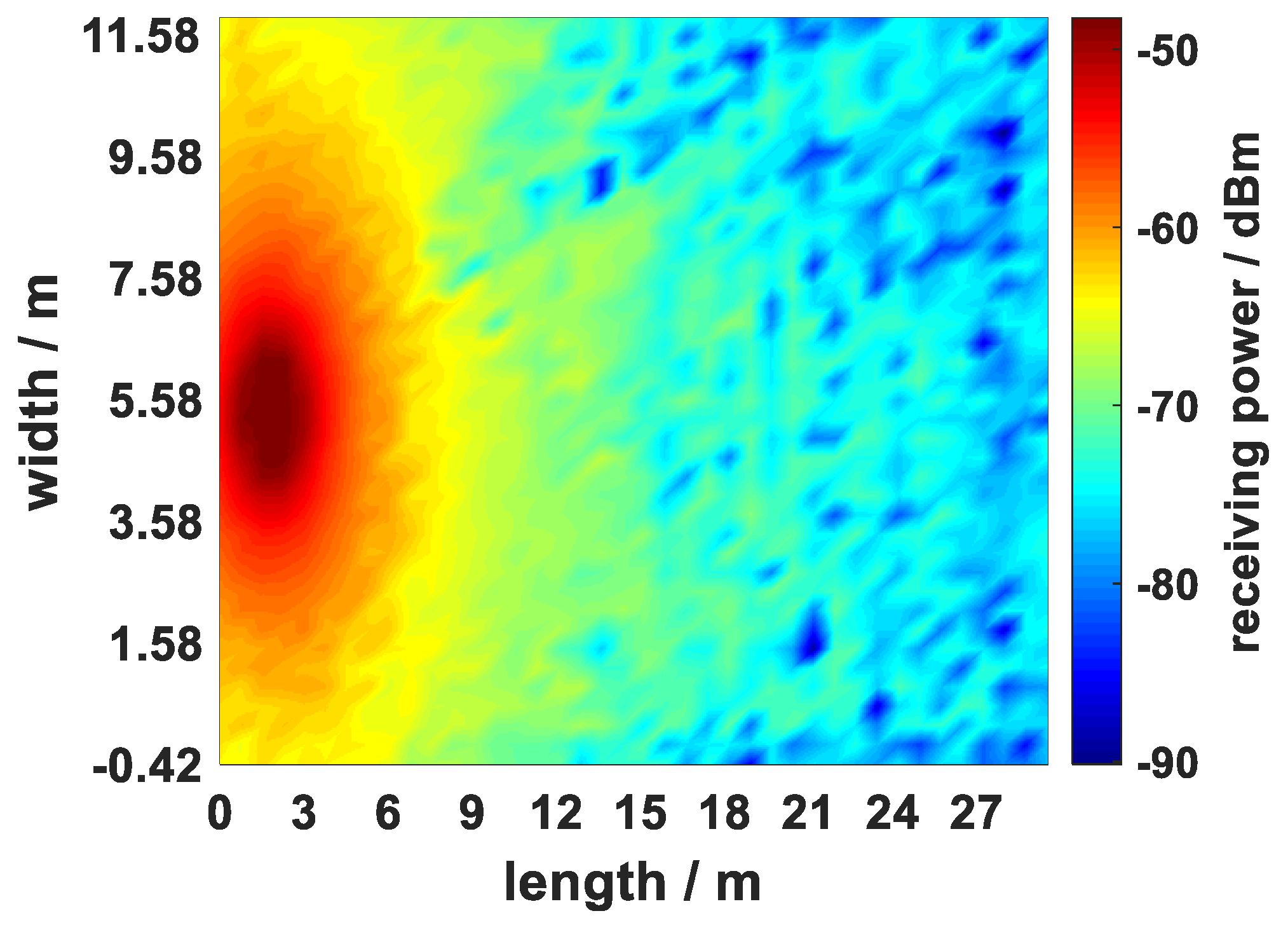
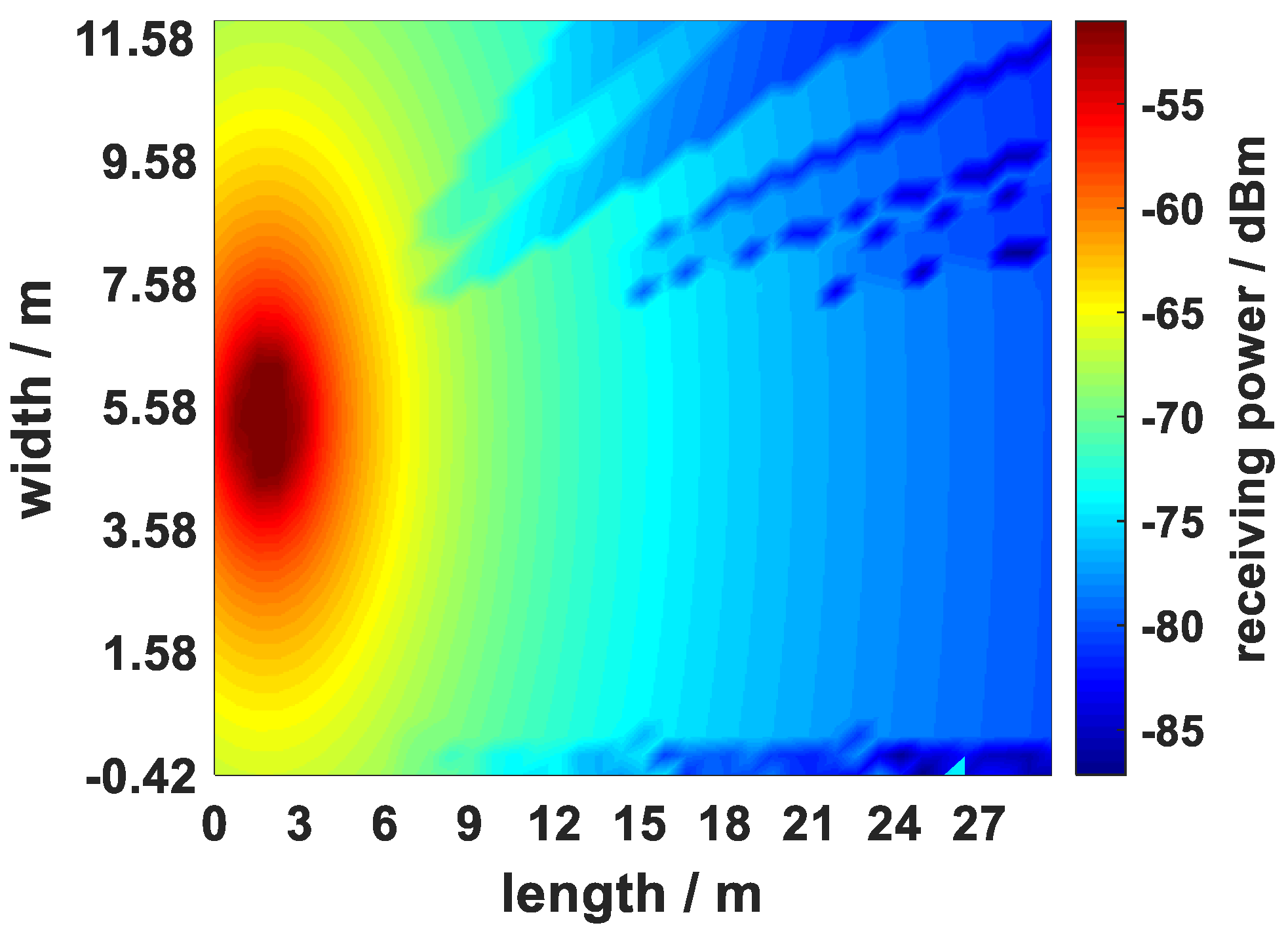
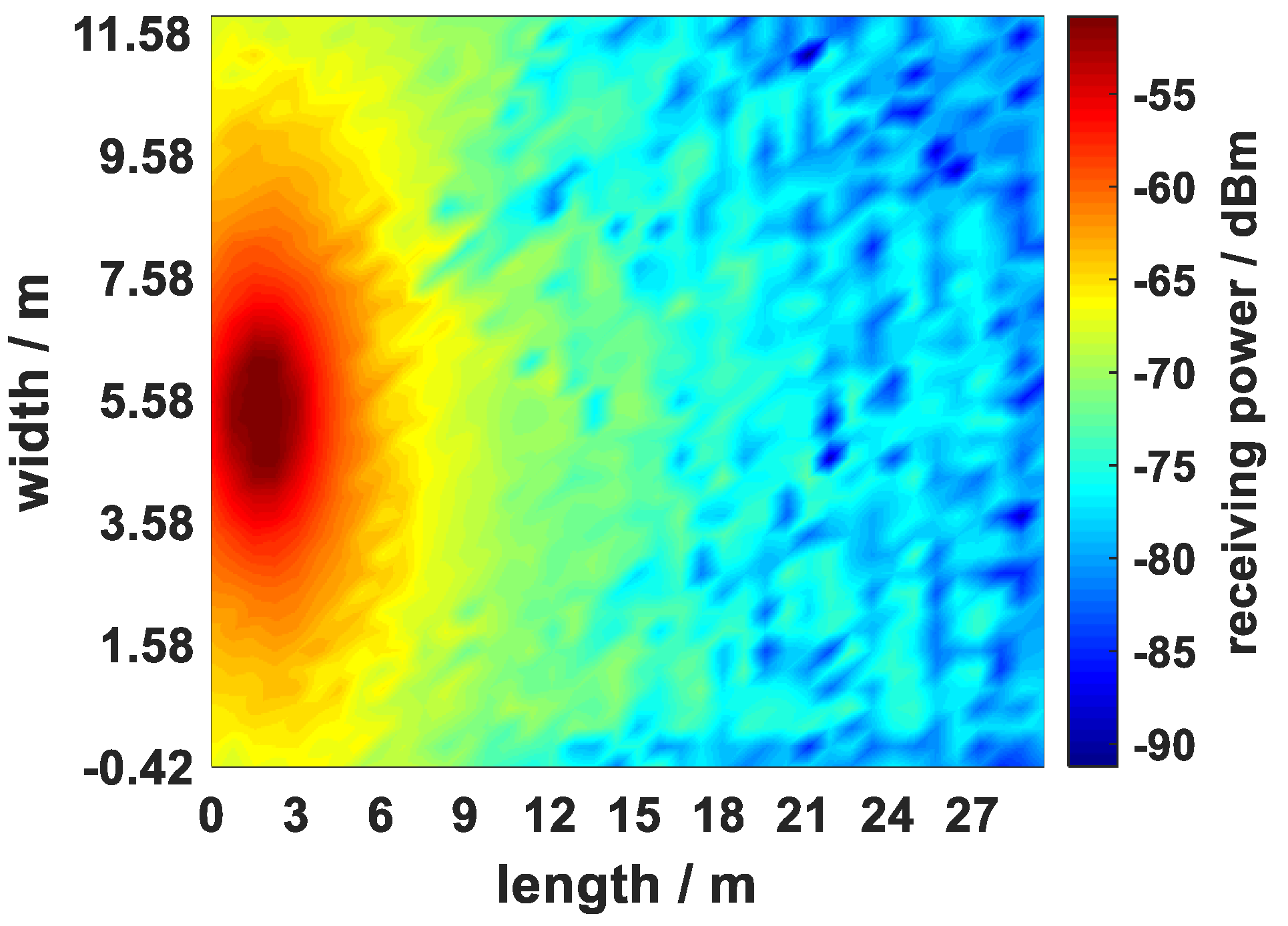
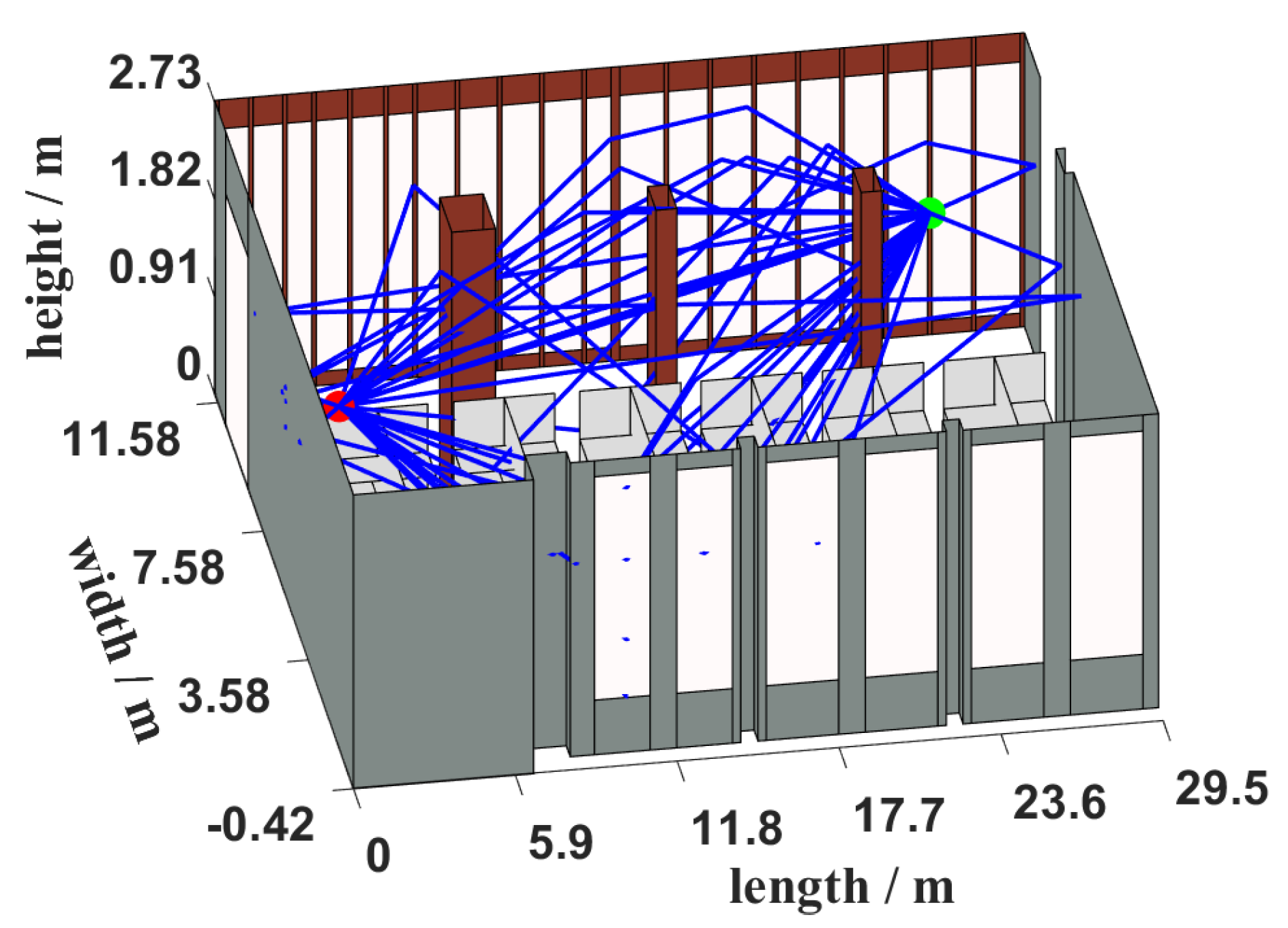
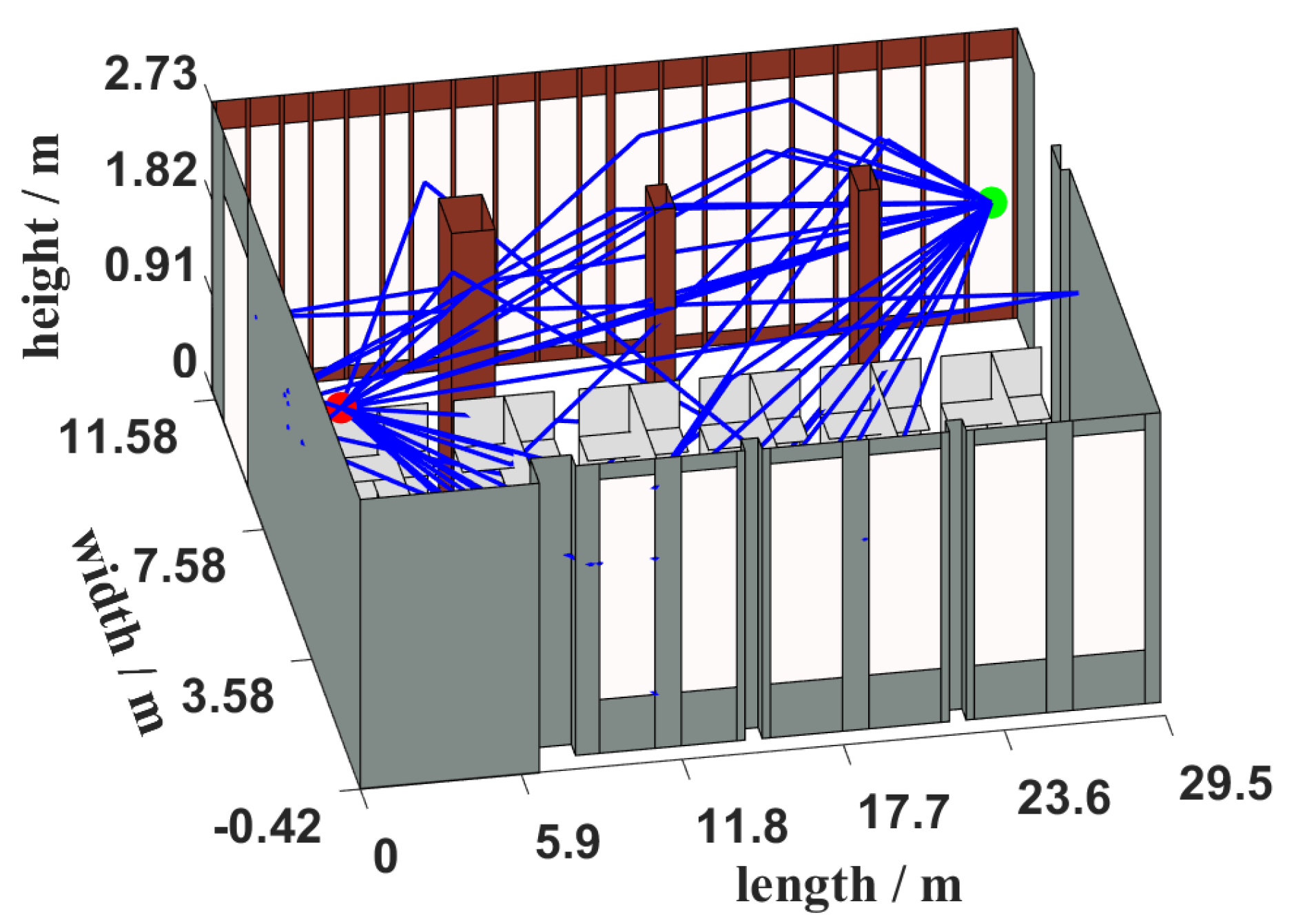
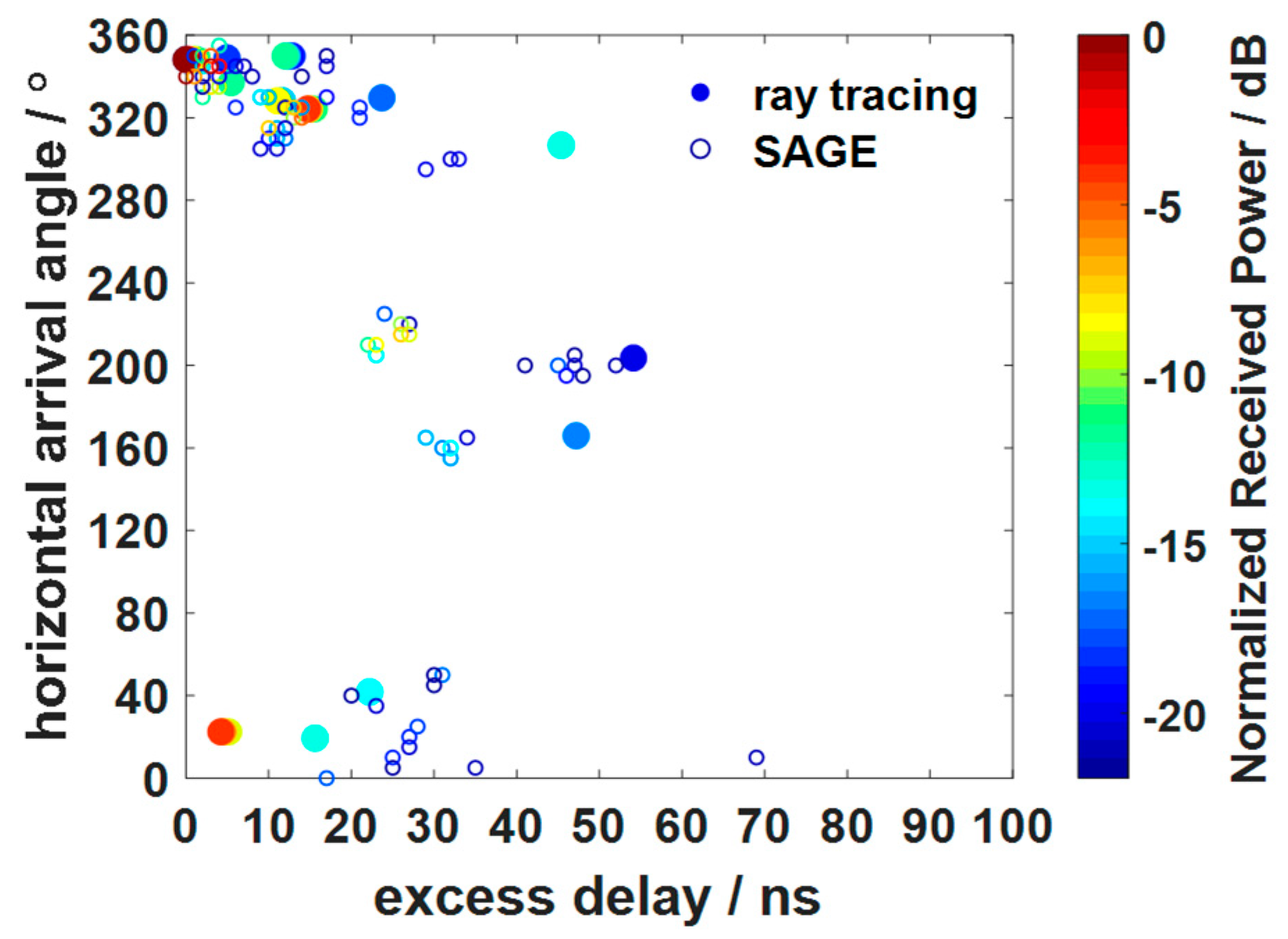


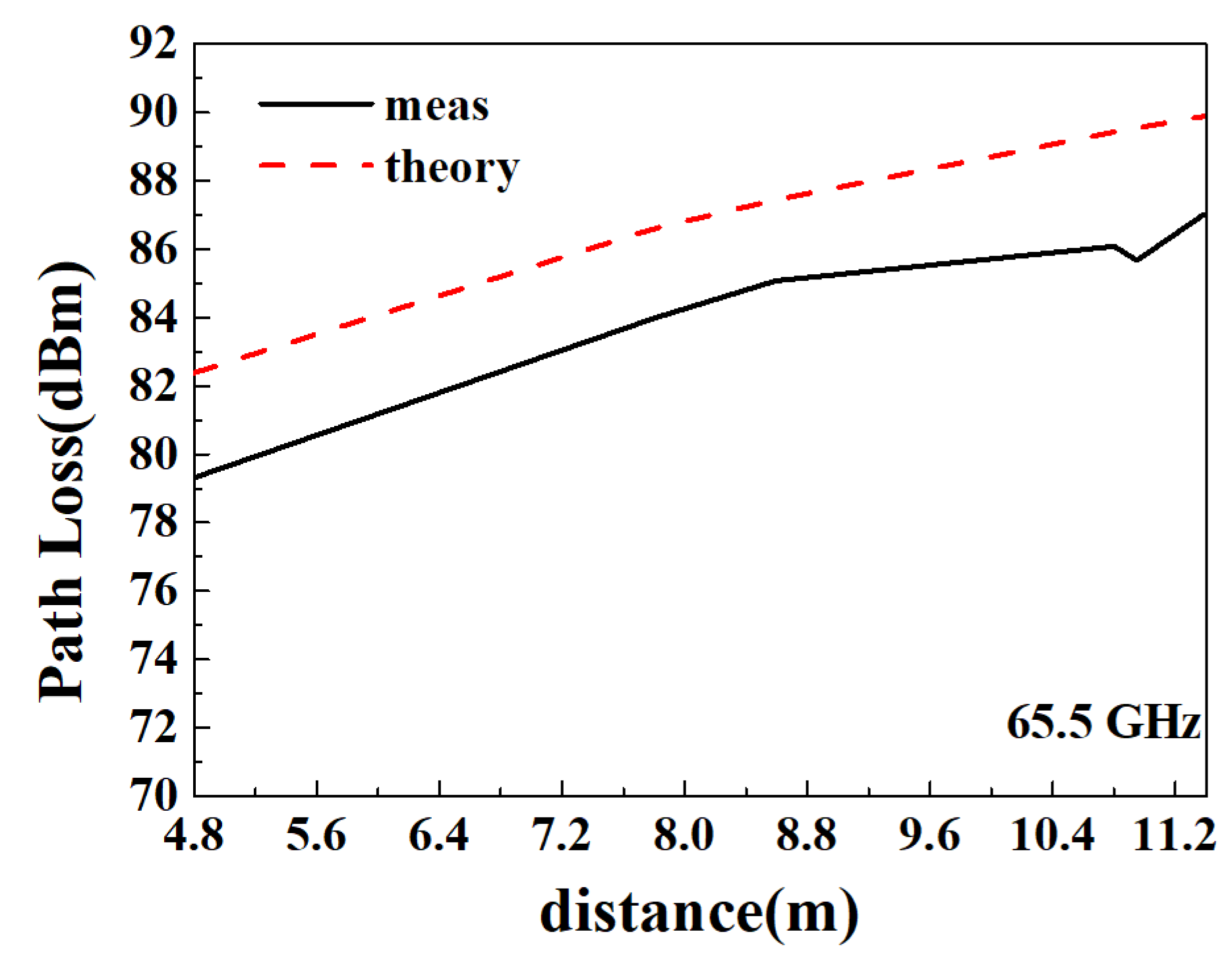

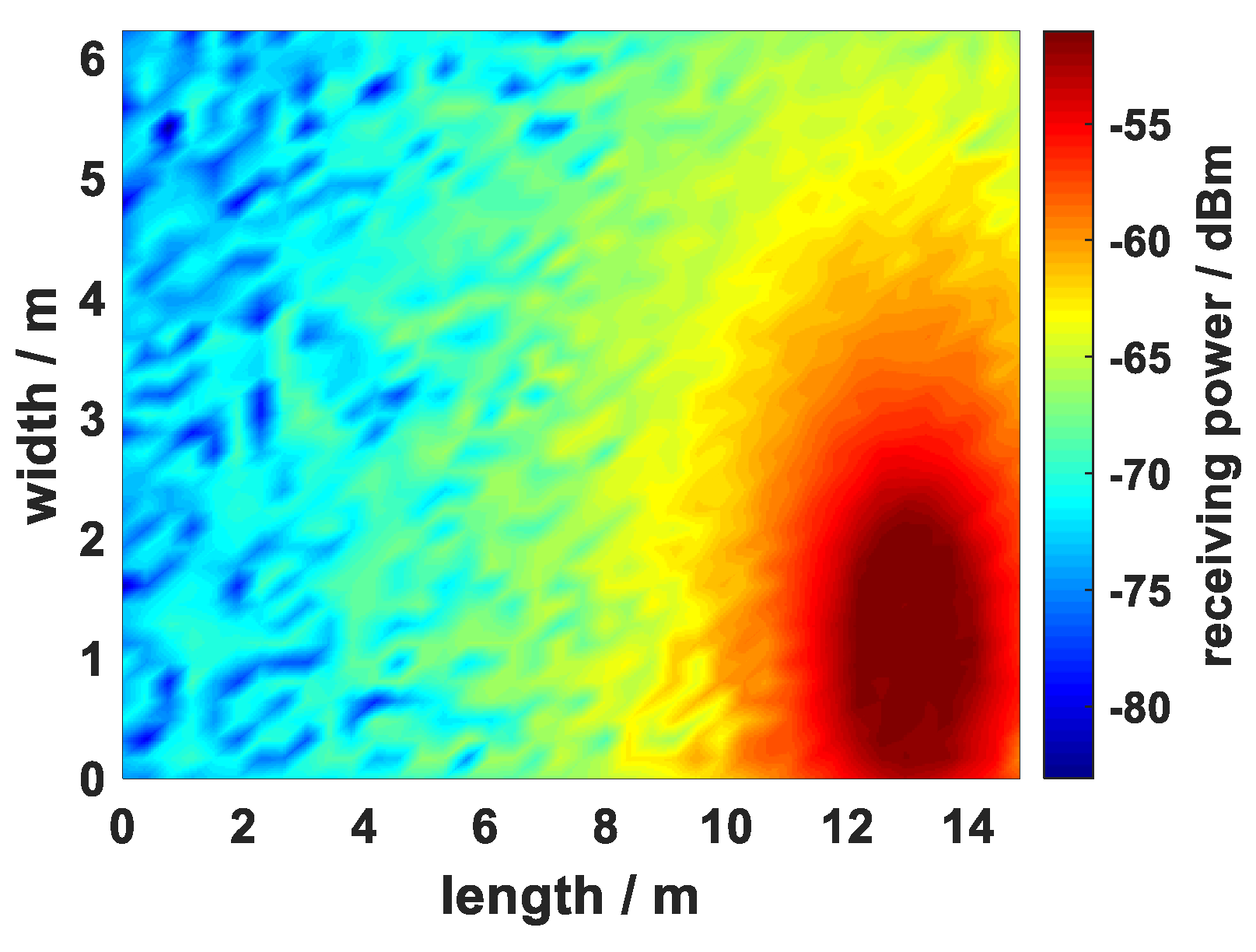

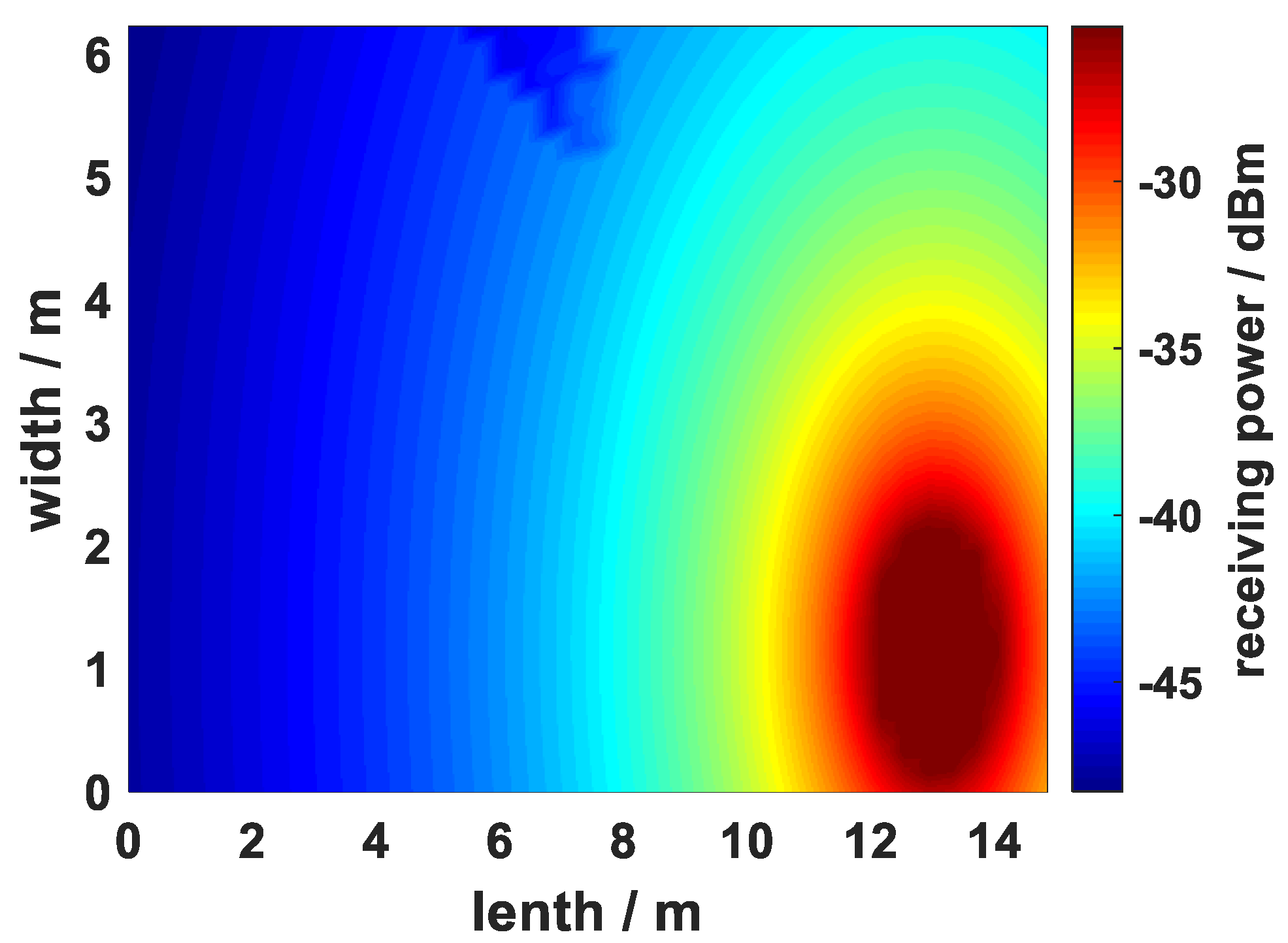
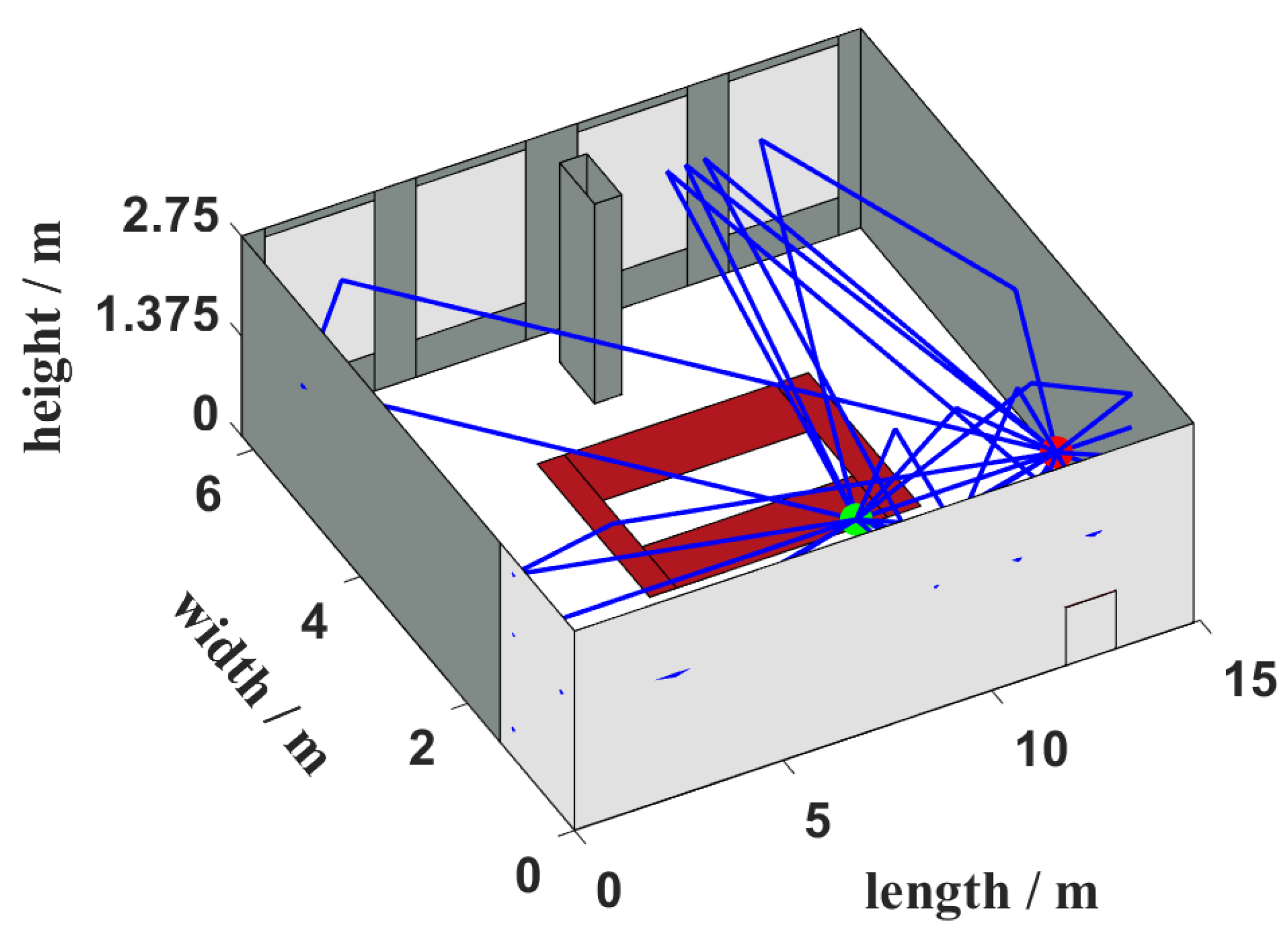
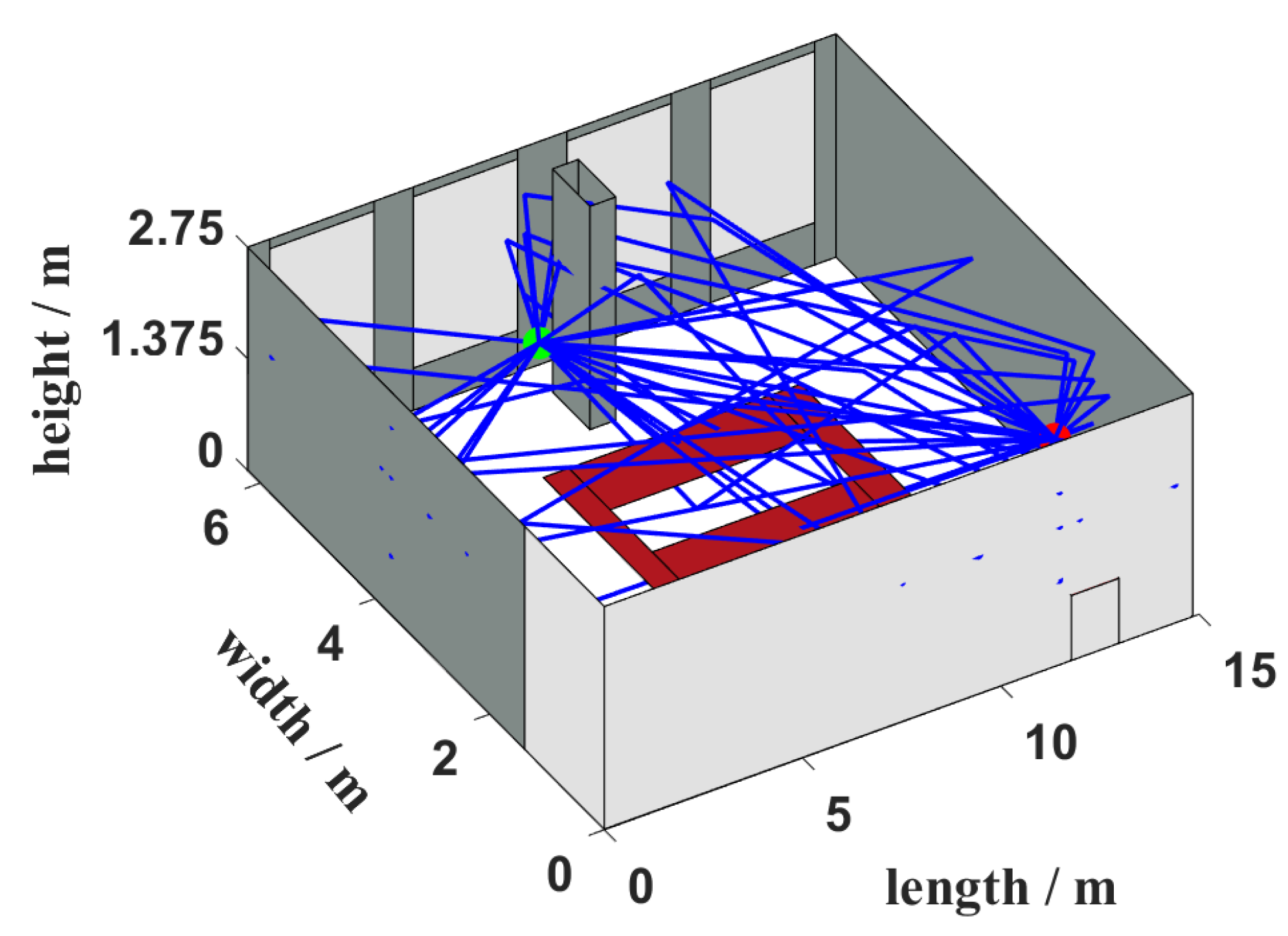
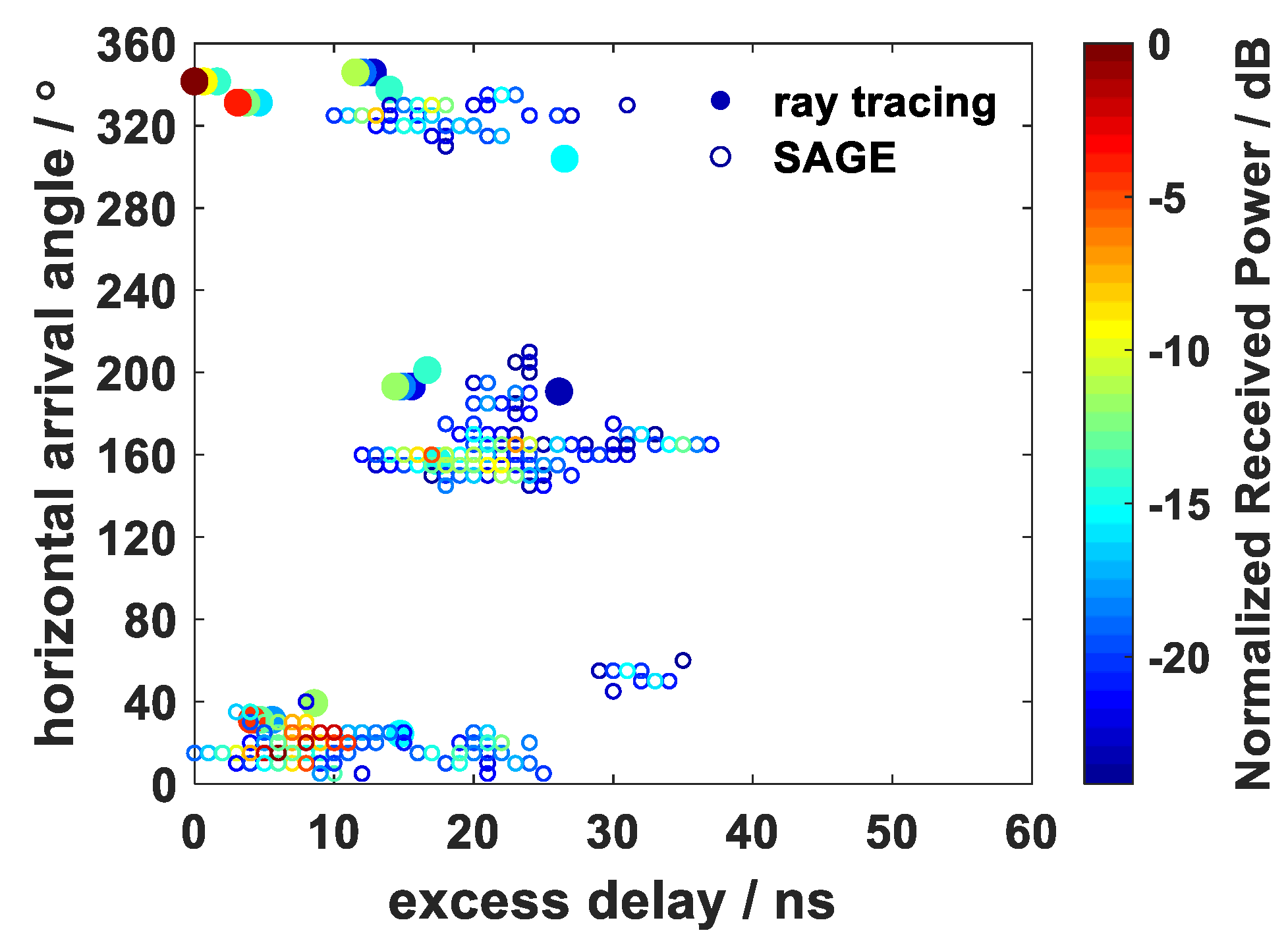
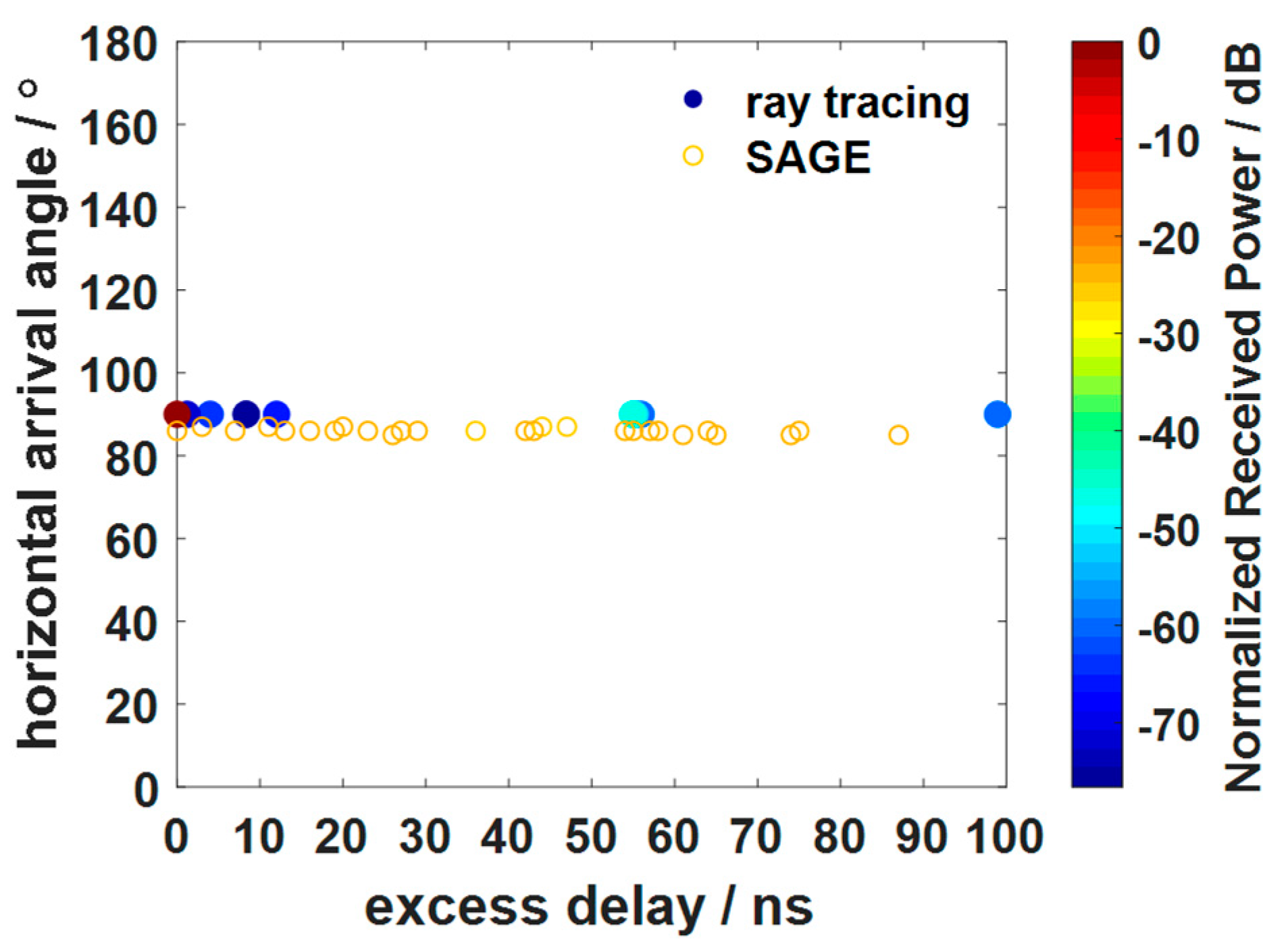
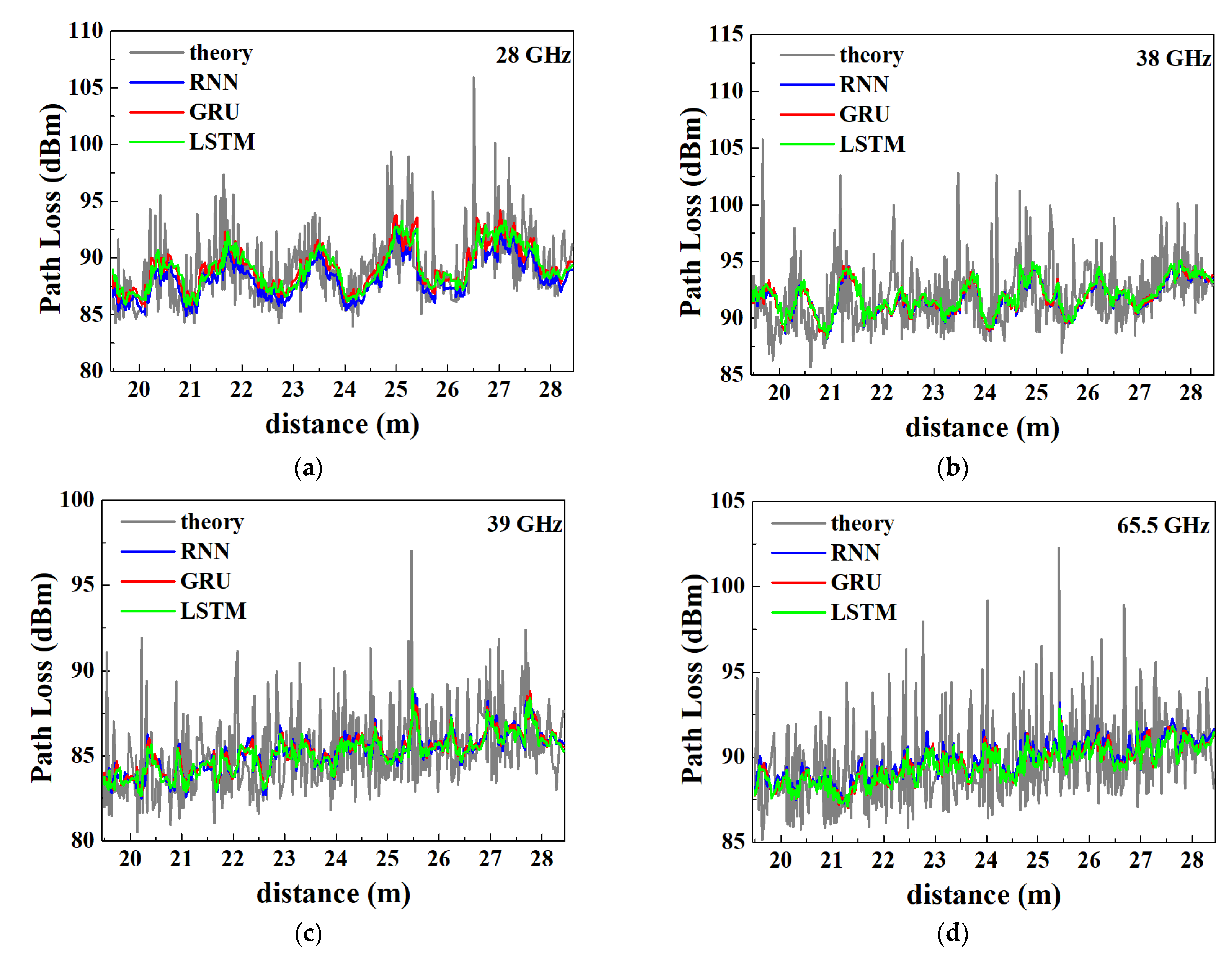
| Physical Parameters | Value |
|---|---|
| Frequency(GHz) | 28/38 |
| Bandwidth (MHz) | 500 |
| Code length | 1024 |
| Transmitting antenna | Omnidirectional Antenna |
| Receiving antenna | Horn Antenna |
| Gain of transmitting antenna (dB) | 4.5 (28 GHz); 6.2 (38 GHz) |
| Gain of receiving antenna (dB) | 24.8 (28 GHz); 26.9 (38 GHz) |
| The height of receiver/transmitter antenna (m) | 1.8/1.8 |
| Transmission power (dBm) | 0 |
| Physical Parameters | Value |
|---|---|
| Frequency(GHz) | 39 |
| Bandwidth (GHz) | 1 |
| Code length | 1024 |
| Transmitting antenna | Omnidirectional Antenna |
| Receiving antenna | Horn Antenna |
| Gain of transmitting antenna (dB) | 6.2 |
| Gain of receiving antenna (dB) | 26.92 |
| The height of receiver/transmitter antenna (m) | 1.68/1.68 |
| Physical Parameters | Value |
|---|---|
| Frequency(GHz) | 65.5 |
| Bandwidth (GHz) | 1 |
| Code length | 1024 |
| Transmitting antenna | Horn Antenna |
| Receiving antenna | Horn Antenna |
| Gain of transmitting antenna (dB) | 21.68 |
| Gain of receiving antenna (dB) | 21.68 |
| The height of receiver/transmitter antenna (m) | 1.8/1.8 |
| Frequency/GHz | RMSE/dB | MAE/dB |
|---|---|---|
| 28 | 3.418 | 3.206 |
| 38 | 4.6163 | 3.6485 |
| Frequency/GHz | RMSE/dB | MAE/dB |
|---|---|---|
| 39 | 2.1722 | 1.7233 |
| 65.5 | 3.0669 | 3.0276 |
| Frequency (GHz) | 28 | 38 | 39 | 65.5 |
|---|---|---|---|---|
| ERROR | RMSE/MAE (dB) | RMSE/MAE (dB) | RMSE/MAE (dB) | RMSE/MAE (dB) |
| RNN | 2.635/1.8813 | 2.7284/2.7284 | 2.2648/1.7827 | 2.4447/1.9061 |
| GRU | 2.5046/1.8628 | 2.7055/1.9773 | 2.2342/1.7593 | 2.4152/1.8362 |
| LSTM | 2.4949/1.8451 | 2.6881/1.9745 | 2.2091/1.7328 | 2.4041/1.8164 |
Disclaimer/Publisher’s Note: The statements, opinions and data contained in all publications are solely those of the individual author(s) and contributor(s) and not of MDPI and/or the editor(s). MDPI and/or the editor(s) disclaim responsibility for any injury to people or property resulting from any ideas, methods, instructions or products referred to in the content. |
© 2023 by the authors. Licensee MDPI, Basel, Switzerland. This article is an open access article distributed under the terms and conditions of the Creative Commons Attribution (CC BY) license (https://creativecommons.org/licenses/by/4.0/).
Share and Cite
Hou, C.; Li, Q.; Zhang, J.; Zhang, Y.; Guo, L.; Zhu, X.; Ji, H.; Li, S. Research on Propagation Characteristics Based on Channel Measurements and Simulations in a Typical Open Indoor Environment. Electronics 2023, 12, 3546. https://doi.org/10.3390/electronics12173546
Hou C, Li Q, Zhang J, Zhang Y, Guo L, Zhu X, Ji H, Li S. Research on Propagation Characteristics Based on Channel Measurements and Simulations in a Typical Open Indoor Environment. Electronics. 2023; 12(17):3546. https://doi.org/10.3390/electronics12173546
Chicago/Turabian StyleHou, Chunzhi, Qingliang Li, Jinpeng Zhang, Yushi Zhang, Lixin Guo, Xiuqin Zhu, Hanjie Ji, and Shuangde Li. 2023. "Research on Propagation Characteristics Based on Channel Measurements and Simulations in a Typical Open Indoor Environment" Electronics 12, no. 17: 3546. https://doi.org/10.3390/electronics12173546
APA StyleHou, C., Li, Q., Zhang, J., Zhang, Y., Guo, L., Zhu, X., Ji, H., & Li, S. (2023). Research on Propagation Characteristics Based on Channel Measurements and Simulations in a Typical Open Indoor Environment. Electronics, 12(17), 3546. https://doi.org/10.3390/electronics12173546








